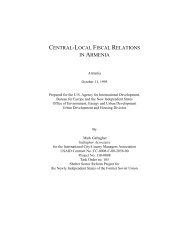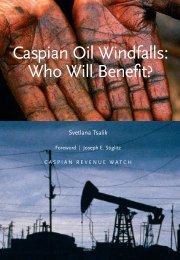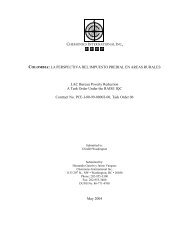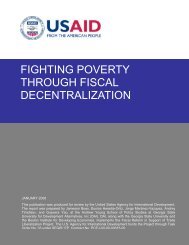Effectiveness and Economic Impact of Tax Incentives in the SADC ...
Effectiveness and Economic Impact of Tax Incentives in the SADC ...
Effectiveness and Economic Impact of Tax Incentives in the SADC ...
Create successful ePaper yourself
Turn your PDF publications into a flip-book with our unique Google optimized e-Paper software.
7-18 EFFECTIVENESS AND IMPACT OF TAX INCENTIVES IN THE <strong>SADC</strong> REGION<br />
•<br />
•<br />
The Ramatex textile factory <strong>in</strong> Namibia unquestionably based its location decision on <strong>the</strong><br />
<strong>in</strong>centive package that <strong>in</strong>cluded both tax <strong>and</strong> non-tax concessions.<br />
In Botswana, <strong>the</strong> government considers as reasonably successful its 15 percent tax rate for<br />
manufacturers, <strong>and</strong> more recently for International F<strong>in</strong>ancial Services Centers. S<strong>in</strong>ce 1996,<br />
120 manufactur<strong>in</strong>g companies have been established under this program, <strong>and</strong> <strong>the</strong> new IFSC<br />
program is generat<strong>in</strong>g a good early response.<br />
One can f<strong>in</strong>d many o<strong>the</strong>r <strong>in</strong>stances throughout <strong>the</strong> region where <strong>in</strong>vestment <strong>in</strong>centives have<br />
delivered results. But <strong>the</strong>se positive examples are <strong>the</strong> exception ra<strong>the</strong>r than <strong>the</strong> rule. In most<br />
<strong>SADC</strong> countries, tax <strong>in</strong>centives have not generated substantial volumes <strong>of</strong> <strong>in</strong>vestment nor<br />
large ga<strong>in</strong>s <strong>in</strong> employment. As discussed <strong>in</strong> Chapter 2, taxes do affect <strong>in</strong>vestment flows, but<br />
tax <strong>in</strong>centives are a dist<strong>in</strong>ctly secondary consideration for most (but not all) <strong>in</strong>vestors. This<br />
pattern shows up <strong>in</strong> large-scale surveys studies, such as <strong>the</strong> World Bank’s World Bus<strong>in</strong>ess<br />
Environment Survey, <strong>and</strong> microeconomic studies such as that by Macamo (2002), who found<br />
that three-fourths <strong>of</strong> <strong>the</strong> recent <strong>in</strong>vestors he contacted <strong>in</strong> Mozambique would have pursued<br />
<strong>the</strong>ir projects without obta<strong>in</strong><strong>in</strong>g <strong>the</strong> tax <strong>in</strong>centives that <strong>the</strong>y did receive.<br />
Even <strong>in</strong> <strong>the</strong> showcase examples noted above, important qualifications apply. In Mauritius, tax<br />
<strong>in</strong>centives were accompanied by very favorable economic <strong>and</strong> political conditions. So <strong>the</strong><br />
isl<strong>and</strong> nation’s experience does not generalize to most o<strong>the</strong>r countries. 103 In <strong>the</strong> case <strong>of</strong><br />
Lesotho, it rema<strong>in</strong>s to be seen how well <strong>the</strong> garment <strong>in</strong>dustry will hold up to <strong>the</strong> scheduled<br />
lapse <strong>of</strong> <strong>the</strong> AGOA entitlement <strong>in</strong> 2004 <strong>and</strong> <strong>the</strong> term<strong>in</strong>ation <strong>of</strong> o<strong>the</strong>r textile <strong>and</strong> garment<br />
quotas <strong>in</strong> 2005. Temporary advantages may not produce susta<strong>in</strong>able success. With regard to<br />
Mozal, some have suggested that <strong>the</strong> government could have obta<strong>in</strong>ed a better barga<strong>in</strong> <strong>and</strong><br />
more revenue. In <strong>the</strong> case <strong>of</strong> <strong>the</strong> MIDP, even proponents acknowledge that <strong>the</strong> <strong>in</strong>vestment has<br />
been highly capital <strong>in</strong>tensive <strong>and</strong> that <strong>the</strong> boom <strong>in</strong> automotive exports has not created net<br />
new jobs. F<strong>in</strong>ally, <strong>the</strong> Ramatex decision was clearly a case <strong>of</strong> <strong>in</strong>traregional tax competition,<br />
<strong>and</strong> questions have been raised about <strong>the</strong> net benefit for <strong>the</strong> w<strong>in</strong>ner (see Exhibit 6-2).<br />
In short, facts <strong>in</strong> <strong>the</strong> <strong>SADC</strong> region, <strong>and</strong> <strong>in</strong>ternationally, refute any simple claim that tax<br />
<strong>in</strong>centives are highly effective, or never effective. The real issue is, first, to underst<strong>and</strong> <strong>the</strong><br />
conditions <strong>in</strong> which tax <strong>in</strong>centives are likely to succeed or fail, <strong>and</strong> second, to design tax<br />
<strong>in</strong>centive programs, where appropriate, that will maximize <strong>the</strong> positive effects <strong>and</strong> m<strong>in</strong>imize<br />
<strong>the</strong> negative effects. This requires careful policy analysis <strong>in</strong> <strong>the</strong> context <strong>of</strong> each country’s<br />
economic <strong>and</strong> fiscal conditions, <strong>in</strong>stitutions, <strong>and</strong> political preferences.<br />
103 Fur<strong>the</strong>rmore, Mauritius has been fac<strong>in</strong>g what <strong>the</strong> M<strong>in</strong>ister <strong>of</strong> F<strong>in</strong>ance called “severe budget constra<strong>in</strong>ts” <strong>in</strong><br />
his Budget Speech 2003-2004 (paragraph 211). Budget deficits have exceeded 5 percent <strong>of</strong> GDP <strong>in</strong> recent years.<br />
In <strong>the</strong> latest budget, <strong>in</strong>come taxes account for only 14 percent <strong>of</strong> total recurrent revenue.











